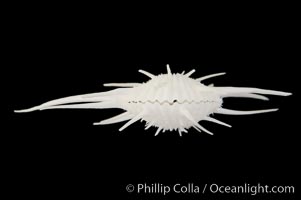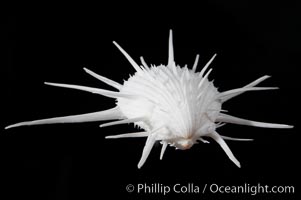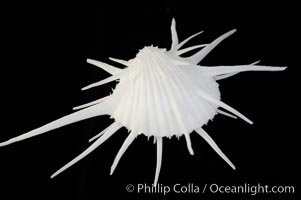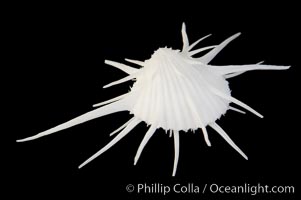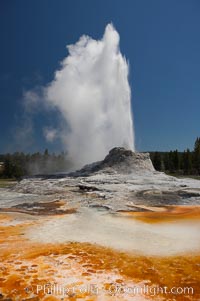
Castle Geyser erupts with the colorful bacteria mats of Tortoise Shell Spring in the foreground. Castle Geyser reaches 60 to 90 feet in height and lasts 20 minutes. While Castle Geyser has a 12 foot sinter cone that took 5,000 to 15,000 years to form, it is in fact situated atop geyserite terraces that themselves may have taken 200,000 years to form, making it likely the oldest active geyser in the park. Upper Geyser Basin.
Location: Upper Geyser Basin, Yellowstone National Park, Wyoming
Image ID: 13418
Location: Upper Geyser Basin, Yellowstone National Park, Wyoming
Image ID: 13418
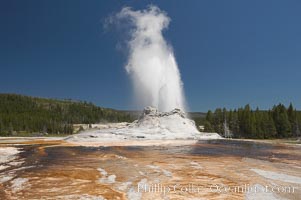
Castle Geyser erupts with the colorful bacteria mats of Tortoise Shell Spring in the foreground. Castle Geyser reaches 60 to 90 feet in height and lasts 20 minutes. While Castle Geyser has a 12 foot sinter cone that took 5,000 to 15,000 years to form, it is in fact situated atop geyserite terraces that themselves may have taken 200,000 years to form, making it likely the oldest active geyser in the park. Upper Geyser Basin.
Location: Upper Geyser Basin, Yellowstone National Park, Wyoming
Image ID: 13420
Location: Upper Geyser Basin, Yellowstone National Park, Wyoming
Image ID: 13420
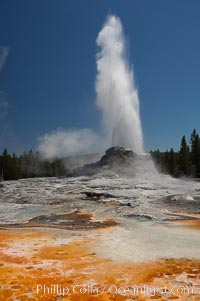
Castle Geyser erupts with the colorful bacteria mats of Tortoise Shell Spring in the foreground. Castle Geyser reaches 60 to 90 feet in height and lasts 20 minutes. While Castle Geyser has a 12 foot sinter cone that took 5,000 to 15,000 years to form, it is in fact situated atop geyserite terraces that themselves may have taken 200,000 years to form, making it likely the oldest active geyser in the park. Upper Geyser Basin.
Location: Upper Geyser Basin, Yellowstone National Park, Wyoming
Image ID: 13421
Location: Upper Geyser Basin, Yellowstone National Park, Wyoming
Image ID: 13421
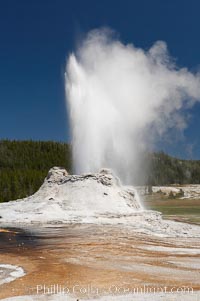
Castle Geyser erupts with the colorful bacteria mats of Tortoise Shell Spring in the foreground. Castle Geyser reaches 60 to 90 feet in height and lasts 20 minutes. While Castle Geyser has a 12 foot sinter cone that took 5,000 to 15,000 years to form, it is in fact situated atop geyserite terraces that themselves may have taken 200,000 years to form, making it likely the oldest active geyser in the park. Upper Geyser Basin.
Location: Upper Geyser Basin, Yellowstone National Park, Wyoming
Image ID: 13425
Location: Upper Geyser Basin, Yellowstone National Park, Wyoming
Image ID: 13425
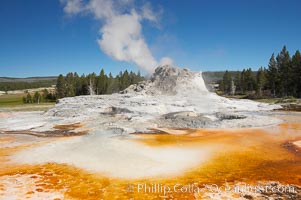
Castle Geyser (during steam phase, not eruption) with the colorful bacteria mats of Tortoise Shell Spring in the foreground. While Castle Geyser has a 12 foot sinter cone that took 5,000 to 15,000 years to form, it is in fact situated atop geyserite terraces that themselves may have taken 200,000 years to form, making it likely the oldest active geyser in the park. Upper Geyser Basin.
Location: Upper Geyser Basin, Yellowstone National Park, Wyoming
Image ID: 13427
Location: Upper Geyser Basin, Yellowstone National Park, Wyoming
Image ID: 13427
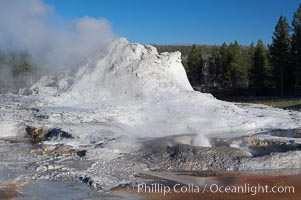
Tortoise Shell Spring bubbles in front of the sinter cone of Castle Geyser. Upper Geyser Basin.
Location: Upper Geyser Basin, Yellowstone National Park, Wyoming
Image ID: 13428
Location: Upper Geyser Basin, Yellowstone National Park, Wyoming
Image ID: 13428
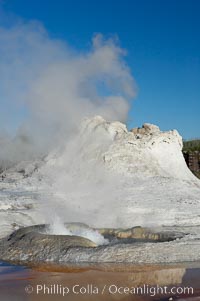
Tortoise Shell Spring bubbles in front of the sinter cone of Castle Geyser. Upper Geyser Basin.
Location: Upper Geyser Basin, Yellowstone National Park, Wyoming
Image ID: 13429
Location: Upper Geyser Basin, Yellowstone National Park, Wyoming
Image ID: 13429
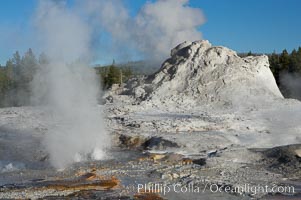
Tortoise Shell Spring bubbles in front of the sinter cone of Castle Geyser. Upper Geyser Basin.
Location: Upper Geyser Basin, Yellowstone National Park, Wyoming
Image ID: 13430
Location: Upper Geyser Basin, Yellowstone National Park, Wyoming
Image ID: 13430
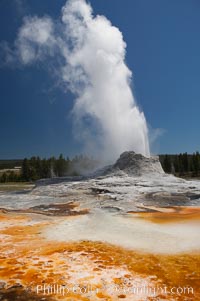
Castle Geyser erupts with the colorful bacteria mats of Tortoise Shell Spring in the foreground. Castle Geyser reaches 60 to 90 feet in height and lasts 20 minutes. While Castle Geyser has a 12 foot sinter cone that took 5,000 to 15,000 years to form, it is in fact situated atop geyserite terraces that themselves may have taken 200,000 years to form, making it likely the oldest active geyser in the park. Upper Geyser Basin.
Location: Upper Geyser Basin, Yellowstone National Park, Wyoming
Image ID: 13437
Location: Upper Geyser Basin, Yellowstone National Park, Wyoming
Image ID: 13437
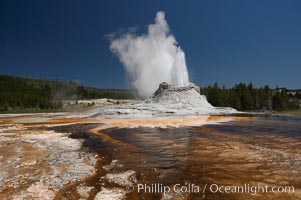
Castle Geyser erupts with the colorful bacteria mats of Tortoise Shell Spring in the foreground. Castle Geyser reaches 60 to 90 feet in height and lasts 20 minutes. While Castle Geyser has a 12 foot sinter cone that took 5,000 to 15,000 years to form, it is in fact situated atop geyserite terraces that themselves may have taken 200,000 years to form, making it likely the oldest active geyser in the park. Upper Geyser Basin.
Location: Upper Geyser Basin, Yellowstone National Park, Wyoming
Image ID: 13443
Location: Upper Geyser Basin, Yellowstone National Park, Wyoming
Image ID: 13443

Castle Geyser erupts with the colorful bacteria mats of Tortoise Shell Spring in the foreground. Castle Geyser reaches 60 to 90 feet in height and lasts 20 minutes. While Castle Geyser has a 12 foot sinter cone that took 5,000 to 15,000 years to form, it is in fact situated atop geyserite terraces that themselves may have taken 200,000 years to form, making it likely the oldest active geyser in the park. Upper Geyser Basin.
Location: Upper Geyser Basin, Yellowstone National Park, Wyoming
Image ID: 13444
Location: Upper Geyser Basin, Yellowstone National Park, Wyoming
Image ID: 13444
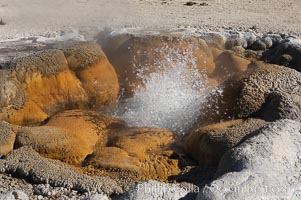
Shell Spring (Shell Geyser) erupts almost continuously. The geysers opening resembles the two halves of a bivalve seashell, hence its name. Biscuit Basin.
Location: Biscuit Basin, Yellowstone National Park, Wyoming
Image ID: 13498
Location: Biscuit Basin, Yellowstone National Park, Wyoming
Image ID: 13498
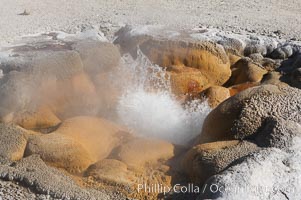
Shell Spring (Shell Geyser) erupts almost continuously. The geysers opening resembles the two halves of a bivalve seashell, hence its name. Biscuit Basin.
Location: Biscuit Basin, Yellowstone National Park, Wyoming
Image ID: 13499
Location: Biscuit Basin, Yellowstone National Park, Wyoming
Image ID: 13499
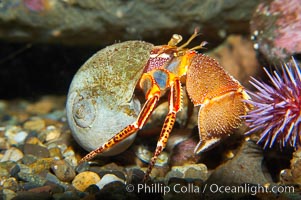
Hermit crab. Hermit crabs wear shells to protect their soft abdomens, which are asymmetrical and curved to fit the spiral shape of their shell. Like all crabs, hermit crabs are decapods; they have five pairs of legs, including a pair of claws. One claw is much larger than the other, the hermit crab uses it for defense and food shredding while it uses the smaller claw for eating. The second and third pairs of legs help the crab walk, and the last two pairs hold the hermit crab in its shell.
Species: Hermit crab, Pagurus
Image ID: 13693
Species: Hermit crab, Pagurus
Image ID: 13693
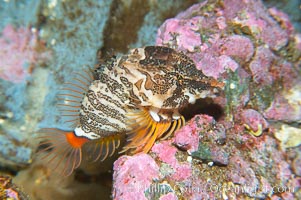
Grunt sculpin. Grunt sculpin have evolved into its strange shape to fit within a giant barnacle shell perfectly, using the shell to protect its eggs and itself.
Species: Grunt sculpin, Rhamphocottus richardsoni
Image ID: 13724
Species: Grunt sculpin, Rhamphocottus richardsoni
Image ID: 13724
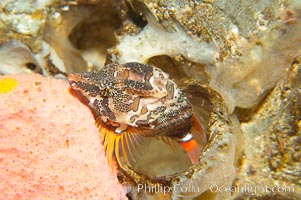
Grunt sculpin poised in a barnacle shell. Grunt sculpin have evolved into its strange shape to fit within a giant barnacle shell perfectly, using the shell to protect its eggs and itself.
Species: Grunt sculpin, Rhamphocottus richardsoni
Image ID: 13725
Species: Grunt sculpin, Rhamphocottus richardsoni
Image ID: 13725
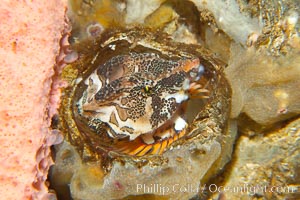
Grunt sculpin poised in a barnacle shell. Grunt sculpin have evolved into its strange shape to fit within a giant barnacle shell perfectly, using the shell to protect its eggs and itself.
Species: Grunt sculpin, Rhamphocottus richardsoni
Image ID: 13726
Species: Grunt sculpin, Rhamphocottus richardsoni
Image ID: 13726
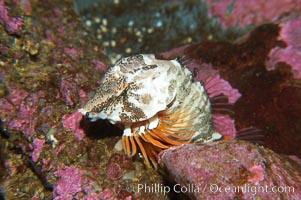
Grunt sculpin. Grunt sculpin have evolved into its strange shape to fit within a giant barnacle shell perfectly, using the shell to protect its eggs and itself.
Species: Grunt sculpin, Rhamphocottus richardsoni
Image ID: 13727
Species: Grunt sculpin, Rhamphocottus richardsoni
Image ID: 13727
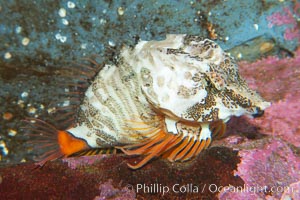
Grunt sculpin. Grunt sculpin have evolved into its strange shape to fit within a giant barnacle shell perfectly, using the shell to protect its eggs and itself.
Species: Grunt sculpin, Rhamphocottus richardsoni
Image ID: 13728
Species: Grunt sculpin, Rhamphocottus richardsoni
Image ID: 13728

Grunt sculpin. Grunt sculpin have evolved into its strange shape to fit within a giant barnacle shell perfectly, using the shell to protect its eggs and itself.
Species: Grunt sculpin, Rhamphocottus richardsoni
Image ID: 13729
Species: Grunt sculpin, Rhamphocottus richardsoni
Image ID: 13729
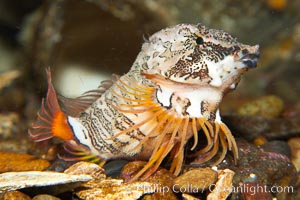
Grunt sculpin. Grunt sculpin have evolved into its strange shape to fit within a giant barnacle shell perfectly, using the shell to protect its eggs and itself.
Species: Grunt sculpin, Rhamphocottus richardsoni
Image ID: 13730
Species: Grunt sculpin, Rhamphocottus richardsoni
Image ID: 13730
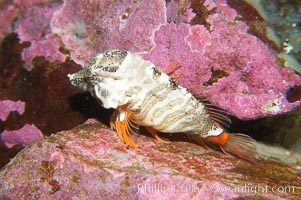
Grunt sculpin. Grunt sculpin have evolved into its strange shape to fit within a giant barnacle shell perfectly, using the shell to protect its eggs and itself.
Species: Grunt sculpin, Rhamphocottus richardsoni
Image ID: 13731
Species: Grunt sculpin, Rhamphocottus richardsoni
Image ID: 13731
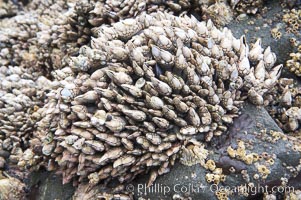
Gooseneck barnacles, exposed at low tide, adhere to a rock. The shell, or capitulum, of the gooseneck barnacle grows to be about two inches long. It is made up of small plates, which enclose its soft body. Inside the shell, the barnacle primarily consists of long segmented legs, intestines and stomach.
Species: Gooseneck barnacle, Pollicipes polymerus
Location: Ruby Beach, Olympic National Park, Washington
Image ID: 13779
Species: Gooseneck barnacle, Pollicipes polymerus
Location: Ruby Beach, Olympic National Park, Washington
Image ID: 13779
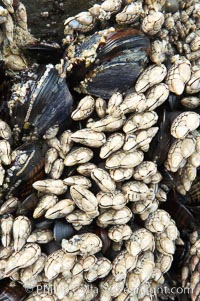
Gooseneck barnacles, exposed at low tide, adhere to a rock. The shell, or capitulum, of the gooseneck barnacle grows to be about two inches long. It is made up of small plates, which enclose its soft body. Inside the shell, the barnacle primarily consists of long segmented legs, intestines and stomach.
Species: Gooseneck barnacle, Pollicipes polymerus
Location: Ruby Beach, Olympic National Park, Washington
Image ID: 13798
Species: Gooseneck barnacle, Pollicipes polymerus
Location: Ruby Beach, Olympic National Park, Washington
Image ID: 13798
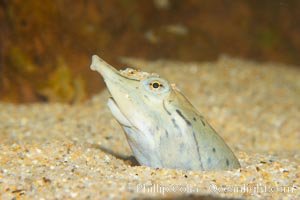
Softshell turtle. Buried in sand, just the head of this softshell turtle is visible.
Species: Softshell turtle, Apalone spinifera
Image ID: 13971
Species: Softshell turtle, Apalone spinifera
Image ID: 13971
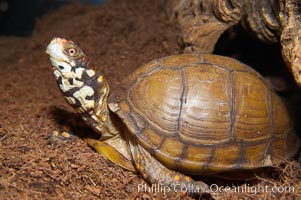
Box turtle. Box turtles are famous for their hinged shells, which allow them to retract almost completely into their bony armor.
Species: Box turtle, Terrapene
Image ID: 13987
Species: Box turtle, Terrapene
Image ID: 13987
